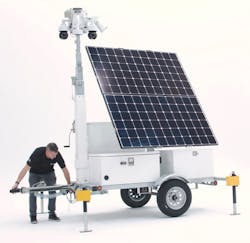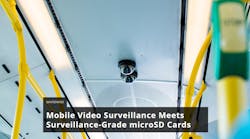Rapidly deployed video surveillance options gain traction
In a security technology industry that already recognizes video surveillance as a driving force of operational transformation, perhaps no sector is as dynamic right now as the mobile video surveillance market. The use cases for rapidly deployed mobile surveillance units are expanding just as quickly as the general mobile video market with the implementation of wireless IP surveillance options and the thirst for advanced video analytics increasing. The most recent industry research pegs this mobile side of the video surveillance market to be valued at close to $1.7 billion with projections reaching $3.72 billion by 2028 – a startling growth rate of almost 11% annually.
A developing market for remote and off-site management of security operations is also driving the necessity for video surveillance command and control alternatives in previously difficult-to-service venues like critical infrastructure, transportation centers, industrial and manufacturing facilities, sports and entertainment locations, construction sites, large outdoor retail spaces and locations where law enforcement requires rapid deployment of security video. Remote viewing and management of security cameras have gained traction in recent years, “fostering the deployment of mobile video surveillance systems on an increasing scale,” touts the research.Remote Mobile is Where It’s At
While mobile video surveillance is commonly associated with police bodycam and dashcams in vehicles, along with a trending use of security drones, security vendors that feature rapid deployment video surveillance are in a unique position of supporting complete surveillance, monitoring and analytics environment with intelligent automation and actionable, real-time data. Using open-sourced cameras and software analytics, users can deploy video anywhere in the field using mobile security trailers, compact tripods and camera mounts. Deployments can be customized with PTZ, thermal, infrared, and panoramic cameras with analytics to enhance situational awareness. The video arrays can be transported to specific exterior locations and powered via solar and supplemented by fuel-cell generators. The adaptability and myriad applications for mobile that is integrating video, audio, sensors and lighting for remote deployment is a novel approach to how video surveillance can be used.
“It's multifaceted in the use cases for this type of mobile video technology. If you think about just the physical security space, you can leverage these in lieu of a security guard. You might be paying a security guard $25 an hour, and that's going to be, if they're there a hundred hours a week, that's around a quarter of a million dollars [per year]. That's very expensive. Or, you can get the same perception of control and video for a fraction of the cost using a mobile video platform,” says Matt Kelley, Head of Retail - Go To Market at LiveView Technologies (LVT).
Kelley, who recently joined the company after a decade as a Senior Manager for Asset Protection at Home Depot, admits it is what lies beyond the technology that bridges the business management gap that impressed him as a former end-user. The ability to translate the deployment of mobile and remote video surveillance into tangible ROI is invaluable.“You can send alerts to a guard if you choose to deploy a guard in the same location. And that's just the overt physical impression of control. You can also put a tower far away from your facility and still have eyes on the entire facility. You can spread your allocation, your dollars farther using a parking lot tower. You can also use that force multiplier approach if you happen to have an event in the parking lot area. It can help foster that relationship with law enforcement,” Kelley says. “You can have cameras in areas you otherwise wouldn’t because you've got a self-contained power source. You've got the ability to push video and data out to the cloud, which a lot of CCTV platforms require on-prem servers, which ours doesn't. There's a lot of other ability that is novel that other platforms and other technologies don't afford.”
The fact that this video platform allows for the open-source integration of devices is another attractive feature Kelley liked. The solution is camera-agnostic and can fit any legacy or video options end-user clients request.
“There's a lot of big box retail that requires NDAA, and don’t want cameras manufactured overseas. But then there are other clients that don't care as much about that. We can take any camera and attach it to one of our units. That goes for other platforms, as well -- not just cameras, but we can use other analytic platforms to bolt onto ours as well,” he adds.
Managing a New Pitch
The versatility and unique platform that LVT is pitching to its clients has not only won the praises of a growing legion of end-users in the commercial, law enforcement and public safety markets, it recently added a distinctive pitchman in former Major League Baseball All-Star and two-time National League Most Valuable Player, Dale Murphy.
Following his retirement from professional baseball in 1993 after 18 years in the big leagues – the bulk of which were with the Atlanta Braves – Murphy has had a laundry list of activities that have kept him busy, from a goodwill ambassador for the sport, personal appearances and sports memorabilia events to opening his own restaurant with his wife Nancy at Truist Park, the home of the Braves. Unfortunately, Murph’s was forced to close during the COVID pandemic (recently reopening near the ballpark).
When the pandemic shut down most of Murphy’s activities over the last two years, he decided to stay put in Utah with his wife and eight children, where he’s been since leaving Atlanta 25 years ago. He took a circuitous route to the company as his eldest son Chad played high school baseball with the brother of current LVT Chief Sales and Marketing Officer David Studdert.
“We stayed connected with the Studdert family, and Nancy said, ‘Dale, you got to get a job’, as things dried up because of COVID. So, she said, ‘Go, talk to Dave. and see if there's a fit for you, and what you could do,”’ chuckles Murphy as he recalls the conversation. “I was hesitant because I was like, oh, man. the whole technology side was out of my league and I'm 66 (years old). I mean, I know what they do, and it's cool, so I went down and talked, and it was just a fantastic meeting. Dave told me that they would find a fit for me since they were expanding into the sports and entertainment areas and already had the Kansas City Chiefs as clients.”
Murphy is currently the Vice President of Sports, part ambassador for the fast-growing organization, and more of a “utility player” as he now calls himself.
“I do try to learn, but obviously I don't know some of the technical aspects and how to explain it,” confesses Murphy. “But I do know what we do and how we do it. I've seen examples of it. I see the effectiveness of it. I went down and helped set up a pilot event with Academy Sports in San Antonio about six weeks ago and was able to convey our story and demonstrated the effectiveness of what we can do. They have ordered up some more (technology) and they're going to roll it out in Austin.”
Making the Use Case for Deployable Video Surveillance
As for Kelley, he does understand the technology and has seen it work up close and personal. Platforms like LVT and others offering similar solutions have become a staple for law enforcement and public safety in times of crisis and also during major events like Super Bowls, Fourth of July parades and socially charged public demonstrations. Being able to place remote eyes and ears on the ground during a major event has proved to be a critical public safety tool.
“The portability part of it is huge. You can have several of these deployed along a parade route, where, if you're a police officer, you're not going to have the line of sight. If you have a security operations center (SOC) set up, then you could have one person monitoring all of those cameras along the parade route. If you add a setup with the analytics using the camera, you are able to say, ‘well, we see this here.’ Then you can start to coordinate (response) efforts,” says Kelley. “If you see an activity and want to take preemptive steps, then you can concentrate your force on that one area and still maintain eyes on the rest of the parade route, for example.”
It is not only the ease of deployment that make solutions like LVT and others like it attractive to large business organizations, event venues and public safety, it is also the application of analytics that help security personnel to be more preemptive than reactive. In today's risk and security environment, preemptive is important.
“The proactive nature of using the analytics creates a lot of effective use cases that are coming out places like the retail space that now are preventing break-ins by having intrusion boxes set up on storefronts overnight. If somebody were to go into that intrusion box, which is basically a box on the storefront using the camera analytics; when somebody broaches that box, it sends an alert to staff in the operations center. They can actually use the talk down functionality to interact with that person in real-time and help to deter the activity,” Kelley says.
“It's about developing an ecosystem where everything plays together. You can only manage what you can measure, which means you want as many data points as you can get, as many systems as you can get talking together. You want your cameras talking to your access control, talking to your burglar alarm panel, talking to your point-of-sale system,” he continues. “Having all those things providing actionable data is the wave of the future. Solution providers are missing the boat trying to have a closed-loop system. Whereas, if you can develop an ecosystem of physical security technologies, then those companies who are building that foundation now are going to be the ones that come out on top in three to five years.”
About the Author: Steve Lasky is a 34-year veteran of the security industry and an award-winning journalist. He is the editorial director of the Endeavor Business Media Security Group, which includes magazines Security Technology Executive, Security Business and Locksmith Ledger International and top-rated webportal SecurityInfoWatch.com. Steve can be reached at [email protected]








